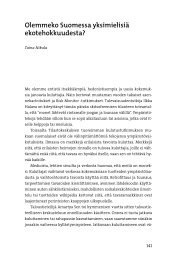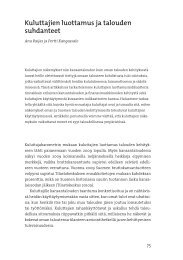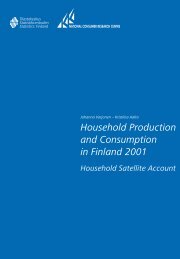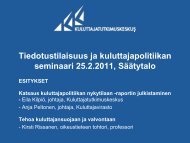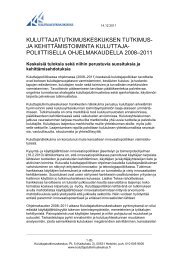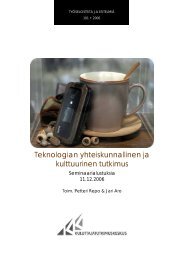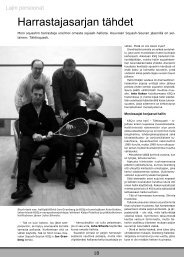Household Production and Consumption in Finland 2001
Household Production and Consumption in Finland 2001
Household Production and Consumption in Finland 2001
You also want an ePaper? Increase the reach of your titles
YUMPU automatically turns print PDFs into web optimized ePapers that Google loves.
7 Integrat<strong>in</strong>g household production<br />
<strong>in</strong>to the national accounts<br />
The basic idea of the <strong>Household</strong> Satellite Account is to calculate a monetary<br />
value for household production <strong>and</strong> to make it visible <strong>in</strong> economic terms.<br />
Further, the idea is to produce a module, a separate account that, if <strong>and</strong> where<br />
necessary, can be <strong>in</strong>tegrated with the national accounts. The <strong>in</strong>tegration of<br />
these different accounts will produce an extended account that describes the<br />
whole economy. Time series on this extended economy offer a different<br />
picture of economic development compared to the core accounts. Accord<strong>in</strong>g<br />
to research by Professor Duncan Ironmonger, household production <strong>and</strong><br />
market production serve as buffers for each other so that dur<strong>in</strong>g strong<br />
bus<strong>in</strong>ess cycles <strong>and</strong> <strong>in</strong>creas<strong>in</strong>g market production, household production will<br />
tend to recede; <strong>and</strong> dur<strong>in</strong>g weak bus<strong>in</strong>ess cycles, the opposite is true.<br />
Accord<strong>in</strong>g to Ironmonger the ratio is not quite 1:1, but the factor value is<br />
around 0.8 (Ironmonger & Soupournas 2003). As yet no economic time series<br />
are available <strong>in</strong> F<strong>in</strong>l<strong>and</strong> that cut across different bus<strong>in</strong>ess cycles.<br />
In the long term economies are affected not only by cyclical fluctuations,<br />
but also structural changes. <strong>Production</strong> shifts from one sector to another.<br />
These shifts may vary <strong>in</strong> direction <strong>and</strong> <strong>in</strong>tensity at different stages of market<br />
economy development. It is widely agreed that the ma<strong>in</strong> trend is for<br />
production to shift from the household sector to the market economy, but it is<br />
possible that estimates have been exaggerated. There is also movement <strong>in</strong> the<br />
opposite direction, from the public <strong>and</strong> private sector to households, which<br />
may not have been fully recognized. At least it may be said that strong bus<strong>in</strong>ess<br />
development requires <strong>in</strong>creased production <strong>in</strong> the household sector, too. One<br />
example is provided by the <strong>in</strong>creased amount of time spent by households <strong>in</strong><br />
the acquisition of goods <strong>and</strong> services (Varjonen & Aalto 2005).<br />
In the discussion that follows, household production is <strong>in</strong>tegrated with the<br />
household sector accounts of the national accounts <strong>and</strong> with parts of the whole<br />
system of accounts. All the figures are for <strong>2001</strong>. 9<br />
7.1 Integration with household sector accounts<br />
We beg<strong>in</strong> by <strong>in</strong>tegrat<strong>in</strong>g household production with the household sector<br />
accounts <strong>in</strong> the system of national accounts. The sequence of household<br />
accounts is presented <strong>in</strong> detail <strong>in</strong> Tables 1 <strong>and</strong> 2 of Appendix 9. One factor<br />
that somewhat complicates the <strong>in</strong>tegration is that part of household<br />
production (13%) is already <strong>in</strong>cluded <strong>in</strong> the national accounts. To avoid<br />
duplicate count<strong>in</strong>g, a column has been added to the <strong>in</strong>tegrated tables under<br />
the head<strong>in</strong>g: Adjustments (SNA – non-SNA). In the production account,<br />
generation of <strong>in</strong>come account <strong>and</strong> capital account deductions are entered <strong>in</strong><br />
9 The FISIM (F<strong>in</strong>ancial Intermediation Services Indirectly Measured) methodological revisions<br />
made to the national accounts <strong>in</strong> summer 2005 have not been taken <strong>in</strong>to account. Therefore<br />
the figures describe the situation <strong>in</strong> spr<strong>in</strong>g 2005.<br />
62 Statistics F<strong>in</strong>l<strong>and</strong> National Consumer Research Centre




